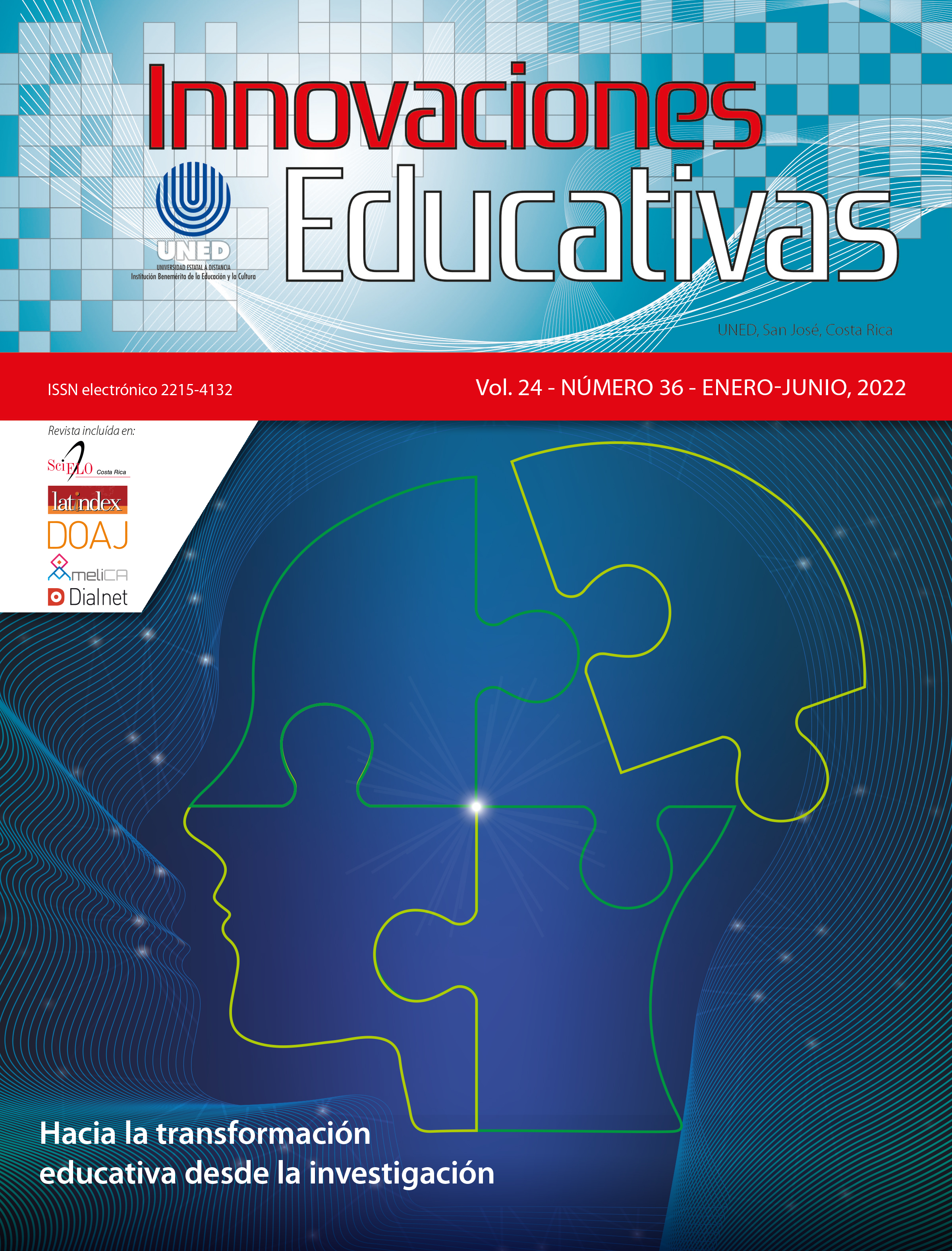The eye-tracking technique and the study of tacit models using subjective and behavioral criteria.
DOI:
https://doi.org/10.22458/ie.v24i36.3894Keywords:
Tacit models, eye tracking, neuropsychology, cognitive process, learning, mathematics teachingAbstract
This article presents the results of a mixed-approach research study, where the eye movement of the undergraduate students of the Austral University of Chile is examined while solving a questionnaire where tacit models appear, related to mathematical infinity, to determine possible correlations between the ocular activity parameters and the level of difficulty of each of these models. The categories of the level of difficulty were established based on two types of criteria: a subjective one, through an evaluation, carried out by the subjects, and a behavioral one, related to obtaining the correct solution. The correlations of these criteria with the ocular activity parameters were identified and considered indicators of mental effort. The analysis of the data obtained allowed us to observe discrepancies in the categorization of the tacit models based on subjective and behavioral criteria. There was a negative correlation of the eye movement parameters with students' opinions about question difficulty levels. In contrast, a strong positive and significant correlation was noted between the presence of these models and the level of difficulty, determined by the percentage of correct answers. In turn, the percentage of correct answers had a strong positive and significant correlation with most of the ocular activity parameters. These results conclude that these parameters can be used to index this activity's tacit model's difficulty level.
References
BACHELARD, G. (2004). La formación del espíritu científico. México: Siglo XXI. (Publicado en 1938).
BACKS, R. y WALRATH, L. C. (1992). Eye movement and pupillary response indices of mental workload during visual search of symbolic displays. Applied Ergonomics, 23 (4), 243-254.
BALAJ, B. y SZUBIELSKA, M. (2004). The influence of catalog description, listening on visual scan-ning of paintings. En S. Grucza, M. Pluzyczka, P. Soluch (Eds.), Widziane inaczej.Z. polskich badan eyetrackingowych, 77-90.
BELMONTE, J. L. y SIERRA, M. (2011). Modelos intuitivos del infinito y patrones de evolución nivelar. Revista Latinoamericana de Investigación en Matemática Educativa, 14(2), 139-171.
BOLZANO, B. (1991). Las paradojas del infinito. D.F., México: Universidad Nacional Autónoma de México.
D’AMORE, B. (2011). La didáctica del infinito matemático. En AA. VV., Memorias del XXIV Coloquio Distrital de Matemáticas y Estadística, Bogotá, Colombia. CD. ISBN 978-958-57050-0-5, 21-29.
D’AMORE, B. y MARTINI, B. (1997). Contrato didáctico, modelos mentales y modelos intuitivos en la resolución de problemas escolares típicos. Números, 32, 26-32.
DEBUE, N. y LEEMPUT, C. (2014). What does german load mean? An empirical contribution to the cognitive load theory. Frontier in Psychology, 5, 1099.
DÍAZ-CHANG, T. y ARREDONDO, E. H. (2021a). Aquiles, la tortuga y los modelos tácitos. (En revisión) Enseñanza de las Ciencias.
DÍAZ-CHANG, T. y ARREDONDO, E. H. (2021b). Análisis de cuestionarios en el estudio de modelos tácitos relacionados con el infinito matemático. (En revisión) Revista Conrado.
DUBINSKY, E.; WELLER, K.; MC DONALD, M.; BROWN, A. (2005). Some historical issues and para-doxes regarding the concept of infinity: An APOS-based analysis. Educational studies in Mathematics, 58, 335-359.
FISCHBEIN, E. (2001). Tacit models and infinity. Educational studies in Mathematics, 48, 309-329.
FRANCUZ, P. (2013). Imagia. W kierunku neurokognitywnej teorii Obrazu. Lublin: KUL.
GOLDBERG, H. J.; KOTVAL, X. P. (1999). Computer interface evaluation using eye movements: methods and constructs. International Journal of Industrial Ergonomics, 24, 631-645.
HENDERSON, J. M., HOLLINGWORTH, A. (1998). Eye Movements During Scene Viewing: An Over-view. En G. Underwood (Ed.) Eye Guidance in Reading and Scene Perception, 269-294.
MARSHALL, S. P. (2002). The Index of Cognitive Activity: Measuring Cognitive Workload. Pro-ceedings of the 7th IEEE Conference on Human Factors and Power Plants.
MAY, J. G., KENNEDY, R. S., WILLIAMS, M. C., DUNLOP, W. P., BRANNAN, J. R. (1990). Eye movement indices of mental workload. Acta Psychologica, 75, 75-89.
MENA-LORCA, A.; MENA-LORCA, J.; MONTOYA-DELGADILLO, E.; MORALES, A. y PARRAGUEZ, M. (2015). El obstáculo epistemológico del infinito actual: Persistencia, resistencia y categorías de análisis. RELIME, 18 (3), 329-358.
POOLE, A. y BALL, L. J. (2006). Eye Tracking in HCI and Usability Research. Encyclopedia of Hu-man-Computer interaction, 211-219.
RAMANAUSKAS, N. (2006). Calibration of video-oculographical eye-tracking system. Electronics and Electric Engineering, 8 (72), 65-68.
RAYNER, K. (1998). Eye movement in reading and information processing: 20 years of research. Psychological Bulletins, 124(3), 372-422.
SOLUCH, P. y TARNOWSKI, A. (2013). O metodologii badan eyetrackingowych. Lingwistyka Sto-sowana, 7, 115-134.
STEINMAN, R. M. (2004) Gaze control under natural conditions. En L. M. Chalupa y J. S. Werner (Eds.) The Visual Neurosciences, Cambridge: MIT Press, 1339-1356.
STROHMAIER, A. R.; MACKAY, K. J.; OBERSTEINER, A. y REISS, K. M. (2020). Eye-tracking meth-odology in mathematics education research: A systematic literature review. Educational Studies in Mathematics, 104, 147-200.
SUSAC, A.; BUBIC, A.; KAPONJA, J.; PLANINIC, M. y PALMOVIC, M. (2014). Eye movements reveal students’ strategies in simple equation solving. International Journal of Science and Mathe-matics Education, 12 (3), 555-577.
SWELLER, J. (1994). Cognitive load theory, learning difficulty and instructional design. Learning and Instruction, 4, 293-312.
TALL, D. (1981). Intuitions of infinity. Mathematics in School, 10, 3, 30-33.
YOUNG, M. S. y STANTON, N. A. (2001). Mental workload: theory, measurement and application. En W. Karwowski (Eds) International encyclopedia of ergonomics and human factors. Lon-don: Taylor & Francis, 1, 507-509.

